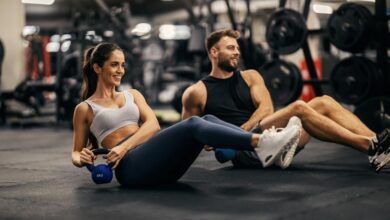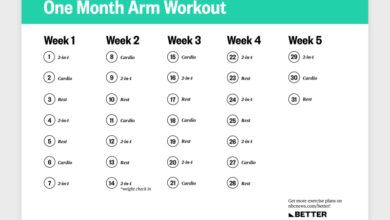
10 Answers to Typical Excuses for Skipping a Workout
10 answers to typical excuses for skipping a workout – We’ve all been there – that moment when the thought of exercise feels like a mountain to climb. “I’m too tired,” “I don’t have time,” or “I’m not motivated” – these are just a few of the common excuses we tell ourselves to avoid a workout.
But what if I told you that these excuses are just roadblocks, and with a little bit of creativity and a shift in perspective, you can overcome them and reap the incredible benefits of regular exercise?
This article explores ten common excuses for skipping a workout and offers practical solutions to help you break through those barriers. Whether you’re dealing with a lack of time, motivation, or simply a feeling of overwhelm, this guide will equip you with the tools and insights you need to make exercise a consistent and enjoyable part of your life.
So, let’s dive in and tackle those excuses head-on!
I’m Not Motivated
We all have those days when the thought of working out feels like climbing Mount Everest. But what if I told you that a simple workout could actually boost your mood and make you feel more energized? Let’s explore the benefits of exercise and how to overcome those unmotivated moments.
The Psychological Benefits of Exercise, 10 answers to typical excuses for skipping a workout
Regular exercise isn’t just about building muscles; it’s a powerful tool for improving mental well-being. Exercise releases endorphins, which have mood-boosting effects similar to those of some medications. Studies have shown that exercise can reduce symptoms of anxiety and depression, improve sleep quality, and increase self-esteem.
It’s like a natural mood enhancer that can help you face the day with more energy and positivity.
Motivational Strategies for Staying Consistent
Consistency is key when it comes to fitness. Here are some strategies to help you stay motivated:
- Find an activity you enjoy:If you dread the treadmill, try something else! Dance, yoga, swimming, hiking – there are endless options. Choose something that gets you excited to move.
- Set realistic goals:Don’t try to become a marathon runner overnight. Start small and gradually increase your intensity and duration. Celebrate each milestone, no matter how small.
- Find a workout buddy:Having someone to exercise with can provide accountability and motivation. You can push each other, celebrate successes, and make working out more fun.
- Reward yourself:Treat yourself to something you enjoy after achieving a fitness goal. This could be a new workout outfit, a massage, or a relaxing dinner.
Setting Realistic Fitness Goals
Setting realistic fitness goals is crucial for staying motivated. Instead of aiming for drastic changes, focus on small, achievable steps. For example, instead of aiming to lose 10 pounds in a week, aim to lose 1-2 pounds per week.
This approach is more sustainable and less likely to lead to discouragement.
Tired of those “I’m too tired” or “I don’t have time” excuses for skipping your workout? I’ve got you covered! I recently wrote a blog post with 10 answers to those common excuses. But hey, if you’re looking to fuel those workouts with healthy carbs, check out this great resource on how to increase carbs with healthy options from a registered dietitian.
Once you’ve got your energy levels up, you’ll be ready to tackle those workouts and crush your fitness goals!
Celebrating Small Victories
Every workout, every healthy meal, and every step you take towards your fitness goals is a victory worth celebrating. Acknowledge your progress, no matter how small, and remind yourself of how far you’ve come. This positive reinforcement will keep you motivated and on track.
Before and After Scenario
Imagine two versions of yourself: the “before” version, struggling with low energy, feeling stressed and sluggish, and the “after” version, radiating energy, feeling confident and strong. Exercise can bridge that gap. It’s not about transforming into a superhero overnight; it’s about gradual, sustainable changes that improve your overall well-being.
The “after” version of you is within reach
all it takes is a commitment to move your body and embrace the positive changes it brings.
We’ve all been there – the “I’m too tired,” “It’s too cold,” or “I don’t have time” excuses for skipping a workout. But sometimes, a little motivation is all you need. And let’s be honest, a warm, comforting bowl of soup can be just the ticket to fuel your body and mind.
If you’re looking for a healthy and satisfying meal that won’t derail your fitness goals, check out these 9 hearty winter soups under 360 calories. They’ll leave you feeling energized and ready to tackle your next workout.
I’m Not Fit Enough
It’s completely understandable to feel intimidated by exercise if you’re not already super fit. But the truth is, exercise is for everyone, regardless of their current fitness level. Starting small and gradually increasing your activity is the key to building a sustainable fitness routine.
Beginner-Friendly Workouts
Starting with beginner-friendly workouts is essential for anyone new to exercise. These workouts are designed to be gentle on your body, allowing you to build a foundation of strength and endurance without overwhelming yourself.
- Walking:Walking is a fantastic low-impact exercise that can be easily incorporated into your daily routine. Start with short walks and gradually increase the distance and duration. Aim for at least 30 minutes of brisk walking most days of the week.
- Swimming:Swimming is another excellent low-impact option that provides a full-body workout. The buoyancy of the water supports your joints, making it ideal for people with injuries or limitations. Start with short swimming sessions and gradually increase the duration and intensity.
- Yoga:Yoga is a practice that combines physical postures with breathing exercises and meditation. It improves flexibility, strength, and balance. Begin with beginner-friendly yoga classes or online videos, and gradually progress to more challenging poses as you gain strength and flexibility.
We’ve all been there – that moment when we’re about to hit the gym, but an excuse pops up. “I’m too tired,” “I don’t have time,” or “I’ll do it tomorrow.” But with gyms reopening, it’s time to overcome those excuses.
Learn about the new safety measures and protocols at gyms by checking out this helpful guide: how gyms are reopening and steps to stay safe. With all the precautions in place, there’s no better time to get back to your fitness routine and finally conquer those excuses!
Gradually Increasing Intensity
Once you’ve established a regular exercise routine, you can gradually increase the intensity of your workouts. This could involve:
- Adding Resistance:Incorporate light weights, resistance bands, or bodyweight exercises to challenge your muscles.
- Increasing Duration:Gradually extend the time you spend exercising, whether it’s walking, swimming, or other activities.
- Adding Intervals:Introduce short bursts of high-intensity exercise into your workouts, such as sprinting or jumping jacks.
Progression from Beginner to Intermediate Fitness Levels
The following flowchart illustrates a typical progression from beginner to intermediate fitness levels:
Beginner:Start with low-impact exercises like walking, swimming, or yoga. Focus on consistency and gradually increase duration. Intermediate:Introduce resistance training, increase workout intensity with intervals, and explore new activities like running or cycling.
I’m Afraid of Getting Injured
It’s completely understandable to be concerned about getting injured while working out. After all, nobody wants to be sidelined by pain or discomfort. But the good news is that with proper form, a solid warm-up, and a bit of awareness, you can significantly reduce your risk of injury.
Proper Form and Warm-Up Techniques
Proper form is the cornerstone of injury prevention. When you execute exercises correctly, you distribute stress evenly across your muscles and joints, minimizing the chance of strain or overuse.
- Before starting any workout, it’s crucial to warm up your muscles. A good warm-up increases blood flow, improves flexibility, and prepares your body for the demands of exercise. A dynamic warm-up, involving controlled movements like arm circles, leg swings, and torso twists, is ideal.
- Once your warm-up is complete, focus on maintaining proper form throughout your workout. This means using the correct range of motion, engaging the right muscles, and avoiding excessive weight or resistance. If you’re unsure about proper form, it’s always a good idea to consult with a qualified fitness professional.
Listening to Your Body
One of the most important aspects of injury prevention is learning to listen to your body.
- Pay attention to any pain or discomfort you experience during your workouts. If you feel a sharp, shooting pain, stop immediately. This could be a sign of a serious injury.
- If you feel a dull ache or tightness, it’s important to slow down and rest. This could be a sign of muscle fatigue or overuse.
- Pushing yourself too hard too soon can lead to injury. Start with a manageable level of activity and gradually increase the intensity and duration of your workouts as you get stronger.
Seeking Guidance from a Fitness Professional
A qualified fitness professional can be a valuable asset in your journey to injury prevention.
- They can assess your current fitness level, identify any potential risk factors, and design a safe and effective workout program tailored to your individual needs.
- A fitness professional can also provide guidance on proper form, teach you how to listen to your body, and help you develop a progressive training plan that minimizes the risk of injury.
Common Exercise Injuries
It’s helpful to understand some of the most common exercise injuries and how to prevent them.
| Injury | Cause | Prevention Strategies |
|---|---|---|
| Sprains and Strains | Sudden twisting or pulling of ligaments or muscles. | Proper warm-up, gradual increase in intensity, focus on controlled movements. |
| Tendonitis | Inflammation of a tendon, often due to overuse or repetitive movements. | Proper warm-up, stretching, avoiding overexertion, gradual increase in weight or resistance. |
| Runner’s Knee | Pain in the front of the knee, often caused by overuse or poor biomechanics. | Proper footwear, stretching, strengthening exercises, gradual increase in mileage. |
| Back Pain | Poor posture, weak core muscles, overuse, or injury. | Proper lifting techniques, core strengthening exercises, stretching, maintaining good posture. |
I’m Not Seeing Results
It’s completely understandable to feel discouraged if you’re not seeing immediate results from your workouts. The truth is, fitness journeys are a marathon, not a sprint. Patience and consistency are key to achieving your goals. Remember, every workout, no matter how small, is a step in the right direction.
Tracking Progress and Celebrating Milestones
Keeping track of your progress can help you stay motivated and see how far you’ve come. There are several ways to track your progress, including:
- Weightlifting:Record the weight you lift and the number of repetitions you complete. As you get stronger, you’ll be able to lift more weight or do more reps.
- Cardio:Track your distance, time, and pace. You may notice you’re able to run farther, faster, or for longer periods of time.
- Body Measurements:Take measurements of your waist, hips, and thighs. Even if you don’t see a significant change on the scale, you may notice a decrease in these measurements.
- Progress Photos:Take photos of yourself in the same outfit at regular intervals. This will help you see the changes in your body over time.
Celebrating milestones is important for maintaining motivation. When you reach a goal, take the time to acknowledge your achievement. This could be anything from treating yourself to a healthy meal to buying yourself a new workout outfit.
I’m Too Old: 10 Answers To Typical Excuses For Skipping A Workout
It’s never too late to start exercising! Many people believe that exercise is only for young people, but that’s simply not true. Exercise is beneficial at any age, and it can help you stay healthy, active, and independent as you age.
The Benefits of Exercise for Older Adults
Regular exercise offers numerous benefits for older adults, including:
- Improved Cardiovascular Health:Exercise strengthens the heart and improves blood circulation, reducing the risk of heart disease, stroke, and other cardiovascular problems.
- Increased Muscle Mass and Strength:Exercise helps maintain muscle mass and strength, which is essential for maintaining mobility, balance, and independence.
- Enhanced Bone Density:Weight-bearing exercises help increase bone density, reducing the risk of osteoporosis and fractures.
- Improved Mood and Cognitive Function:Exercise releases endorphins, which have mood-boosting effects. It also improves blood flow to the brain, which can enhance cognitive function and memory.
- Reduced Risk of Chronic Diseases:Regular exercise can help lower the risk of developing chronic diseases such as type 2 diabetes, obesity, and some types of cancer.
Examples of Active Older Adults
There are countless examples of older adults who are living proof that age is just a number. For instance,
“Fauja Singh, an Indian-born British marathon runner, began running at the age of 89 and has completed several marathons, including the London Marathon. He holds several world records for his age group.”
His story is an inspiration to many, demonstrating that with dedication and determination, anyone can achieve their fitness goals, regardless of age.
Maintaining Mobility and Independence
As we age, our bodies naturally become less mobile and more susceptible to injuries. Exercise can help counteract these changes by:
- Improving Balance and Coordination:Exercises that challenge balance and coordination, such as yoga or tai chi, can help prevent falls and maintain independence.
- Strengthening Muscles and Joints:Regular exercise helps strengthen muscles and joints, making it easier to move around and perform daily tasks.
- Increasing Flexibility:Stretching and flexibility exercises improve range of motion, making it easier to get dressed, reach for objects, and perform other activities of daily living.
Age-Appropriate Exercise Options
It’s important to choose exercises that are appropriate for your age and fitness level. Low-impact activities are generally safer and more comfortable for older adults. Some excellent options include:
- Walking:Walking is a great low-impact exercise that can be done almost anywhere. It’s a good way to improve cardiovascular health, increase muscle strength, and boost mood.
- Swimming:Swimming is another excellent low-impact exercise that is easy on the joints. It’s a great way to improve cardiovascular health, increase muscle strength, and improve flexibility.
- Cycling:Cycling is a good way to improve cardiovascular health and lower body strength. Consider using a stationary bike if you prefer indoor exercise or have concerns about balance.
- Yoga:Yoga is a great way to improve flexibility, balance, and strength. It can also help reduce stress and improve sleep quality.
- Tai Chi:Tai chi is a gentle form of exercise that involves slow, flowing movements. It can help improve balance, coordination, and flexibility.
- Strength Training:Strength training is essential for maintaining muscle mass and strength. It can be done with weights, resistance bands, or bodyweight exercises. Start with light weights and gradually increase the resistance as you get stronger.
Final Thoughts

Remember, exercise isn’t about perfection; it’s about progress. It’s about finding what works for you, celebrating small victories, and embracing the journey. So, ditch the excuses, listen to your body, and get moving. You’ll be amazed at the positive impact it has on your physical and mental well-being.






